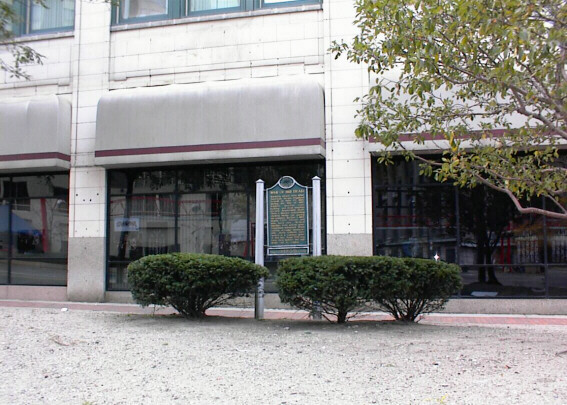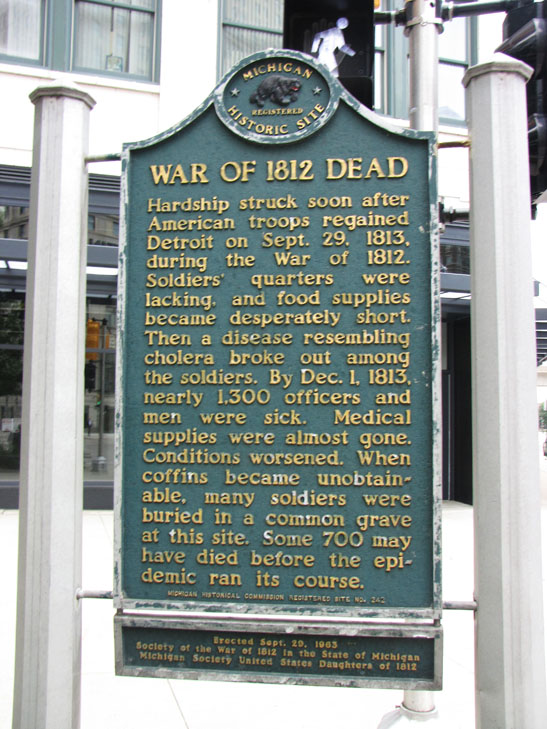

On June 18, 1812, the US declared war on Britain
fearing that British troops would invade Atlantic ports while British forces
in Canada would
effectively unite with Indians to invade the country from the West. At this
time, American control of the upper Midwest was not firm, but there was
a string
of forts running from Ohio in the east to Wisconsin in the West. Detroit was
a key location since it appeared to be the ideal place for a British invasion
from
Canada. General William Hull commanded the small American force in Detroit
and realized that Indians from the South and West might attack him. Early
in July,
he invaded Canada and proposed attacking the British at Fort Malden, but was
persuaded not to do so since British General Brock was marching toward the
Americans
with a force of several hundred. The early months of the war were disastrous
for the Americans in the Midwest since Indian allies effectively attacked
many
of the US forts in the area. US forces were poorly coordinated and much in
fear of the devastation that Indians could produce. Early in August 1812,
a small
group of Indians, led by Tecumseh, killed and injured a substantial fraction
of Detroit's American forces in a skirmish near Brownstown. Thinking that
a major
British force was about to attack Detroit along with their Indian allies, and
unaware of the nearby presence of two American forces, General Hull surrendered
Detroit to the British without any fighting. Thus, the British and their Indian
allies took over the small village. General Hull was later court-marshaled
for
cowardness, neglect of duty, conduct unbecoming an officer and treason. He
was found guilty of all charges except treason, but President Madison stayed
his execution.
Hull commanded the small American force in Detroit
and realized that Indians from the South and West might attack him. Early
in July,
he invaded Canada and proposed attacking the British at Fort Malden, but was
persuaded not to do so since British General Brock was marching toward the
Americans
with a force of several hundred. The early months of the war were disastrous
for the Americans in the Midwest since Indian allies effectively attacked
many
of the US forts in the area. US forces were poorly coordinated and much in
fear of the devastation that Indians could produce. Early in August 1812,
a small
group of Indians, led by Tecumseh, killed and injured a substantial fraction
of Detroit's American forces in a skirmish near Brownstown. Thinking that
a major
British force was about to attack Detroit along with their Indian allies, and
unaware of the nearby presence of two American forces, General Hull surrendered
Detroit to the British without any fighting. Thus, the British and their Indian
allies took over the small village. General Hull was later court-marshaled
for
cowardness, neglect of duty, conduct unbecoming an officer and treason. He
was found guilty of all charges except treason, but President Madison stayed
his execution.
During the summer of 1813, British and American forces fought naval battles on Lake Erie while, on land, Americans fought the British-Indian forces throughout the upper Midwest. Some American successes on Lake Erie led the British to pull their troops from Detroit on September 29, 1813. Americans promptly entered Detroit and renamed the military facilities Fort Shelby after Governor Isaac Shelby of Kentucky who had raised a force of 3,500 to fight the British and Indians in the Midwest. During the fall of 1813, living conditions for the American forces in Detroit began to deteriorate. Food, medicine and supplies ran out and other American forces were unsuccessful in their efforts to resupply Fort Shelby. On December 1,1813, an epidemic broke out, perhaps cholera. Soldiers died so rapidly that many were buried in a common grave at the site of this informational marker. At the beginning of fall 1813, as many as 1,300 troops were stationed in Detroit. Perhaps 700 of them died in the following winter.
In September 1814, American forces guided by Thomas McDonough defeated a British force invading the United States in a battle near Lake Champaign. Without being wiped out, the British tired of this war, recognized their prospects for ending American independence were dim, and so the war was ended with the Treaty of Ghent on December 24, 1814. There was an unresolved issues about control of islands in the Detroit and St. Mary's Rivers but this was resolved peacefully with the 1842 Webster-Ashburton treaty.
Michigan Register of Historic Sites: P25277, Listed November
17, 1962
Michigan Historical Marker: Erected September 12, 1963. This marker is clearly
visible at the address listed above.